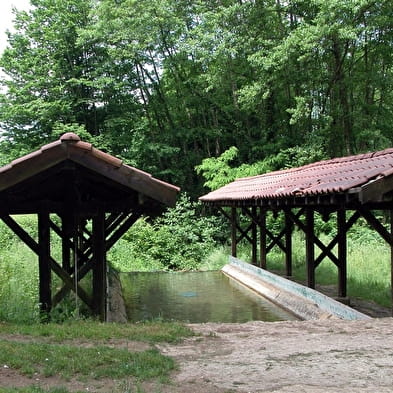
Source de la Reyssouze
Journans, a village in the south of the Revermont, offers several assets: the quality of its grouped habitat, the wealth of its religious buildings (the chapel of Saint-Valérien and the church of Saint-Vincent) and its civil buildings, its wine-growing and gastronomic traditions (calf's head).
Many people also come here because of the karstic source of the Reyssouze at the foot of the Revermont (Jura massif), the longest river in the department, which peacefully winds its way through the southern part of the Bresse plain. Its course is oriented first towards the north and then towards the west. It crosses Bourg-en-Bresse and flows into the Saône on the border of the communes of Reyssouze and Pont-de-Vaux after a journey of about 75 km.
The Vaucluse-type spring can be discovered after following a small path on the right after the local restaurant. Before flowing to the nearby washhouse with its twin frames (19th century), it fills a small circular basin.
This is an ideal place for its freshness and charm, and the site welcomes many visitors. Never dry, the spring's secret may be in the legend.
The origin of the word Reyssouze is uncertain. The first mentions appear in 954-986 (cartulary of Saint-Vincent de Mâcon, n° 327) in the form of in fluvio Resosia, then Resciosa, 996-1018 (ibid. n° 331) and aqua Roissosa (ibid. n° 331) in the 10th century. As for the commune of Reyssouze, it appears in the 10th century, ad Riscosam (ibid. n° 493). For A.-M. Vurpa and C. Michel, the Reyssouze, which gave its name to the village (riscosam in the 10th century, then Resosia in 954), may be reminiscent of the Romanic word *riscia (which would be the same name as the Gallic rusca 'tree bark' from which comes the French 'ruche'), a name which gave rise to the French 'rasse' ('basket') used in Bresse to designate certain embankments: with the Latin suffix -osa, the Reyssouze would be a river lined with embankments (according to G. Taverdet)
Written traces of the Reyssouze can be found from 1272 in accounting documents concerning Pont de Vaux. The name evolves from Roissousa or Royssousa to Reissousa (Accounts of the castellany of Pont-de-Vaux in the departmental archives of the Côte-d'Or and accounts of the syndics of Pont-de-Vaux in the municipal archives (1381-1418)[4]).
According to other sources, the name of the river comes from ru, which means a stream, a river[
The legend of the Reyssouze:
A long time ago, the devil visited an old woman from Journans, named Reyssouze. The Evil One, as usual, proposed to grant her a wish in exchange for her soul. The transaction would take place at midnight and the woman would be able to do, for the rest of her life, precisely what she would do at that hour.
The old woman, after careful consideration, agreed. As she was greedy and stingy, she decided that at midnight she would count her few gold coins hidden deep in her hovel. Thus, she could count gold until her death and would therefore be rich forever...
In addition to her avarice, the vixen was known for her stupidity. So, to make sure she didn't miss the time, she decided to start counting her gold an hour in advance. She would then shuffle her treasure when the fateful hour arrived.
She sat down at her table and scrolled through her coins. Midnight was approaching when an urge seized her. Unfortunately, she held back, wriggled around a lot, and concentrated on her nest egg: nothing helped. When midnight came, she had to give free rein to nature and with her eyes wide open, she poured out like a fountain...
The devil, for once, kept his word! From that night on, the Reyssouze never stopped flowing... it still flows...
- French
- Pets not allowed








